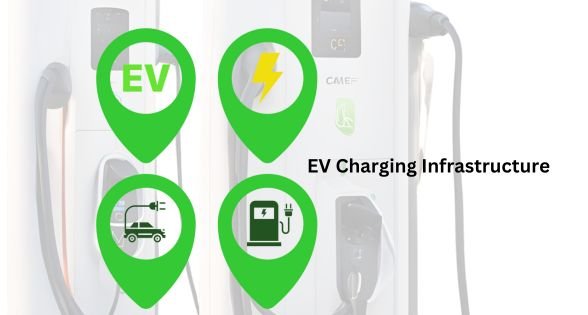Electric Vehicles are transforming transportation, but their growth relies on a robust EV charging infrastructure. The development of this infrastructure is crucial for supporting the increasing number of EVs on the road. This blog will explore the current state of Electric vehicle charging infrastructure, including manufacturers, charging point operators, battery segments, and the different types of chargers. Additionally, we’ll discuss charging times and costs associated with setting up and using these stations.
What is EV Charging Infrastructure?
EV charging infrastructure refers to the network of stations and equipment used to recharge electric vehicles. This includes public charging stations, private home chargers, and workplace charging facilities. The primary goal is to ensure that EV drivers have convenient access to charging points, encouraging the adoption of electric vehicles.
Key Players in EV Charging Infrastructure
Charging Infrastructure Manufacturers
Charging infrastructure manufacturers play a pivotal role in the EV ecosystem. They design and produce the various components needed for charging stations. Major manufacturers are involved in developing both hardware and software solutions, ensuring that their products meet industry standards and support various EV models. Companies such as Tesla, ChargePoint, and ABB are notable players in this field.
Charging Point Operators (CPOs)
Charging Point Operators manage the day-to-day operations of charging stations. They are responsible for the installation, maintenance, and operation of charging points. CPOs also handle customer interactions, including payment processing and customer support. Examples include companies like Blink Charging and EV go, which operate extensive networks of charging stations across different regions.
Battery Segment
The battery segment is integral to the EV charging infrastructure. It involves the production and management of batteries used in electric vehicles. Advances in battery technology, such as lithium-ion batteries and newer solid-state batteries, are crucial for improving the efficiency and range of EVs. The performance of these batteries directly impacts the frequency and speed of charging.
Types of EV Chargers
There are three main types of EV chargers: Level 1, Level 2, and DC Fast Chargers.
Level 1 Chargers
Level 1 chargers are the slowest and are typically used in residential settings. They plug into a standard 120V household outlet. Charging an EV with a Level 1 charger can take up to 24 hours for a full charge, depending on the battery size and vehicle efficiency. For a 1kW battery, it could take around 10-12 hours to charge fully.
Level 2 Chargers
Level 2 chargers are faster and are commonly found in public charging stations and workplaces. They require a 240V outlet and can charge an EV in a few hours. For a 1kW battery, a Level 2 charger can typically complete the charging process in about 2-4 hours.
DC Fast Chargers
DC Fast Chargers are the fastest option available. They are usually installed along highways for long-distance travel and can charge an EV to 80% in about 30 minutes. For a 1kW battery, a DC Fast Charger can recharge it in approximately 10-15 minutes.
Costs Associated with EV Charging Infrastructure
The costs of EV charging infrastructure can vary widely. Installing a Level 1 charger at home is relatively inexpensive, often costing a few hundred dollars. Level 2 chargers are more costly, with installation fees ranging from $500 to $2,000. DC Fast Chargers are the most expensive, with installation costs potentially exceeding $50,000 due to their advanced technology and infrastructure requirements.
Public charging stations often have usage fees, which can be based on time, energy consumption, or a combination of both. The cost to charge an EV at a public station can vary depending on the provider and location. Generally, the cost ranges from $0.10 to $0.30 per kWh.
Benefits of Expanding EV Charging Infrastructure
Expanding EV charging infrastructure offers numerous benefits. It supports the reduction of greenhouse gas emissions by encouraging the use of electric vehicles. Additionally, it can stimulate economic growth by creating jobs in the installation and maintenance of charging stations. Enhanced infrastructure also increases consumer confidence in EVs, leading to higher adoption rates.
Challenges in Developing EV Charging Infrastructure
Despite its benefits, developing EV charging infrastructure faces several challenges. One major issue is the high cost of installation. Installing charging stations, especially DC Fast Chargers, requires significant investment. Another challenge is ensuring compatibility between different EV models and charging stations. Standardizing charging technology is crucial for a seamless user experience. Additionally, there are logistical challenges related to site selection and securing permits for installation.
Future Prospects of EV Charging Infrastructure
The future of EV charging infrastructure looks promising. Advances in technology will likely lead to more efficient and affordable charging solutions. The integration of renewable energy sources, such as solar power, with charging stations is an area of growing interest. Additionally, smart charging technologies, which allow for dynamic pricing and grid balancing, are expected to become more prevalent.
Conclusion
EV charging infrastructure is a critical component of the electric vehicle ecosystem. Its expansion supports the growth of EV adoption, reduces range anxiety, and contributes to environmental sustainability. Key players such as manufacturers and charging point operators play vital roles in this ecosystem. While challenges remain, ongoing investments and technological advancements are paving the way for a more robust and accessible charging network. As the infrastructure continues to evolve, it will play a pivotal role in shaping the future of transportation
